正在加载图片...

Lecture 15 Gene Cloning F is one of many bacterial plasmids,most of which are also transmissible from one cell to another. R factors-This type of plasmid was discovered in Japan in early 1950's.They came from hospital patients that were infected with bacteria that were resistant to several different antibiotics.This was surprising since antibiotics work by very different mechanisms. For example,resistance to ampicillin,kanamycin,tetracycline,and sulfonamide could be conferred at once on transfer of a given R factor.In fact,most of the antibiotic resistance genes are actually in transposons that are carried on the R factor. Sulr Amp Tetr Kanr Modern cloning vectors are stripped down versions of R factors.They usually carry one or two drug resistance genes and an origin of replication. Ampr origin of replication Cloning involves the use of enzymes in vitro to make plasmids carrying pieces of the chromosome.One of the important tools is a set of enzymes that can cleave DNA at specific sites.These enzymes are known as Restriction Enzymes.They were discovered in the following way: E.coliC E.colik (grown on C) 108/ml 103/ml 入(grown on K) 108/ml 108/mlLecture 15 Gene Cloning F is one of many bacterial plasmids, most of which are also transmissible from one cell to another. R factors - This type of plasmid was discovered in Japan in early 1950’s . They came from hospital patients that were infected with bacteria that were resistant to several different antibiotics. This was surprising since antibiotics work by very different mechanisms. For example, resistance to ampicillin, kanamycin, tetracycline, and sulfonamide could be conferred at once on transfer of a given R factor. In fact, most of the antibiotic resistance genes are actually in transposons that are carried on the R factor. Sulr Kanr Ampr Tetr Modern cloning vectors are stripped down versions of R factors. They usually carry one or two drug resistance genes and an origin of replication. Ampr origin of replication Cloning involves the use of enzymes in vitro to make plasmids carrying pieces of the chromosome. One of the important tools is a set of enzymes that can cleave DNA at specific sites. These enzymes are known as Restriction Enzymes. They were discovered in the following way: E. coli C E. coli K λ (grown on C) 108/ml 103/ml λ (grown on K) 108/ml 108/ml